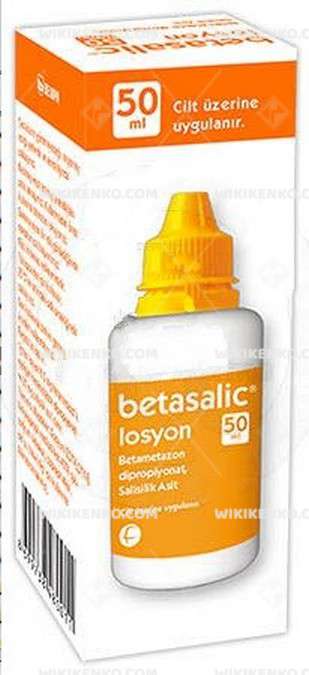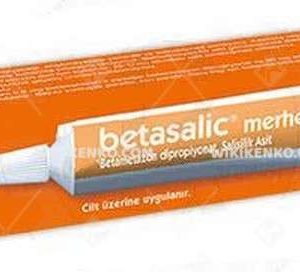Betasalic Lotion
Betasalic Lotion, a powerful medication designed to address a range of skin conditions. With its potent combination of betamethasone dipropionate and salicylic acid, it offers a comprehensive solution for psoriasis, neurodermatitis, lichen ruber planus, eczema, seborrheic skin diseases, and other scaling conditions. Learn about the uses, application, side effects, and precautions associated with it to make informed decisions about your skincare needs.
| Dosage form | |
|---|---|
| Pack size | |
| Potency | 50Ml |
| Manufacturer | |
| Origin | |
| Generic Name (Ingredient) | Betamethasone (As Dipropionate) 0.5 Mg, Salicylic Acid 20.0 Mg |
Assuming your emergency circumstances for this product, visit Urgent Quotation page. Besides, for any pharmaceutical questions, please ask us in the comments section.
Description
Betasalic Lotion belongs to the group of medications known as steroids. It is formulated to effectively treat a variety of skin conditions, providing relief and promoting healthier skin. The key components of it include betamethasone dipropionate, a potent corticosteroid, and salicylic acid, which possesses keratolytic, antibacterial, and antifungal properties.
By combining these active ingredients, it tackles the underlying causes of skin conditions and provides targeted relief.
Uses
Betasalic Lotion is an ideal choice for individuals experiencing the following skin conditions:
Psoriasis: This chronic autoimmune condition causes red, scaly patches on the skin. Betasalic Lotion aids in managing the symptoms associated with psoriasis.
Neurodermatitis (atopic eczema): Neurodermatitis refers to a condition characterized by itchy, inflamed patches of skin. Betasalic Lotion helps alleviate the discomfort caused by neurodermatitis.
Lichen ruber planus: Lichen ruber planus manifests as itchy, purplish bumps on the skin. Betasalic Lotion provides relief and helps reduce the symptoms of lichen ruber planus.
Eczema: Eczema, also known as atopic dermatitis, causes dry, itchy, and inflamed skin. It effectively addresses the symptoms associated with eczema.
Seborrheic skin diseases: Seborrheic dermatitis and other related conditions are characterized by red, flaky skin, typically on the scalp and face. Betasalic Lotion helps manage the symptoms of seborrheic skin diseases.
Subacute and chronic scaling conditions: Betasalic Lotion is also beneficial for other subacute and chronic scaling conditions, providing targeted relief and promoting healthier skin.
How to Use
it is intended for external use only. To ensure optimal results and minimize potential side effects, follow these application guidelines:
Cleanse the affected area: Before applying Betasalic Lotion, gently cleanse the affected area and ensure it is dry.
Apply a thin layer: Using clean hands or a suitable applicator, apply a thin layer of Betasalic Lotion to the affected area.
Avoid contact with sensitive areas: Take care to avoid contact with the eyes, nose, or mouth. In case of accidental contact, rinse thoroughly with plenty of water.
Regular usage: Apply Betasalic Lotion as directed by your doctor. Follow the recommended frequency and duration of application for optimal results.
Side Effects
While Betasalic Lotion is generally well-tolerated, some individuals may experience mild side effects. These side effects are usually temporary and subside over time. Common side effects may include:
- Burning sensation
- Itching
- Irritation
- Redness
- Pain at the site of application
If these side effects persist or worsen, it is important to inform your doctor for further guidance and support.
Precautions
To ensure the safe and effective use of Betasalic Lotion, it is important to adhere to the following precautions:
External use only: it is intended for external use. Avoid contact with the eyes, nose, or mouth.
Avoid broken or infected skin: Do not apply Betasalic Lotion to broken or infected skin as it may lead to further complications. Consult your doctor if you are unsure about the condition of your skin.
Airtight dressings: Unless specifically directed by a doctor, do not cover the treated area with airtight dressings, such as bandages.
Pregnancy and breastfeeding: If you are pregnant or breastfeeding, consult your doctor before using Betasalic Lotion to ensure it is safe for you and your baby.
Allergy history: If you have a history of allergic reactions to any of the ingredients in Betasalic Lotion, inform your doctor before using it.
Reporting side effects: If you experience anyunusual or persistent side effects such as intense burning, severe itching, excessive irritation, or prolonged redness and pain at the site of application, it is important to inform your doctor immediately. They will be able to assess your condition and provide appropriate guidance.
Consult Your Doctor for Personalized Guidance
Prior to starting any new medication, including Betasalic Lotion, it is always recommended to consult with your healthcare provider. They will evaluate your specific needs, medical history, and potential drug interactions to determine if it is the right choice for you. Your doctor can provide personalized guidance on proper usage, precautions, and potential alternatives based on your individual circumstances.
Conclusion
Betasalic Lotion offers a targeted and effective treatment option for various skin conditions, including psoriasis, neurodermatitis, lichen ruber planus, eczema, seborrheic skin diseases, and other subacute and chronic scaling conditions. With its powerful combination of betamethasone dipropionate and salicylic acid, it addresses the underlying causes of these conditions, providing relief and promoting healthier skin.
By following the recommended guidelines for application and precautions, individuals can maximize the benefits of it while minimizing potential side effects. For personalized advice and recommendations, consult your healthcare provider..
Use the form below to report an error
Please answer the questions as thoroughly and accurately as possible. Your answers will help us better understand what kind of mistakes happen, why and where they happen, and in the end the purpose is to build a better archive to guide researchers and professionals around the world.
The information on this page is not intended to be a substitute for professional medical advice, diagnosis, or treatment. always seek the advice for your physician or another qualified health provider with any questions you may have regarding a medical condition. Always remember to
- Ask your own doctor for medical advice.
- Names, brands, and dosage may differ between countries.
- When not feeling well, or experiencing side effects always contact your own doctor.
Cyberchondria
The truth is that when we’re sick, or worried about getting sick, the internet won’t help.
According to Wikipedia, cyberchondria is a mental disorder consisting in the desire to independently make a diagnosis based on the symptoms of diseases described on Internet sites.
Why you can't look for symptoms on the Internet
If diagnoses could be made simply from a textbook or an article on a website, we would all be doctors and treat ourselves. Nothing can replace the experience and knowledge of specially trained people. As in any field, in medicine there are unscrupulous specialists, differences of opinion, inaccurate diagnoses and incorrect test results.




Reviews
There are no reviews yet.